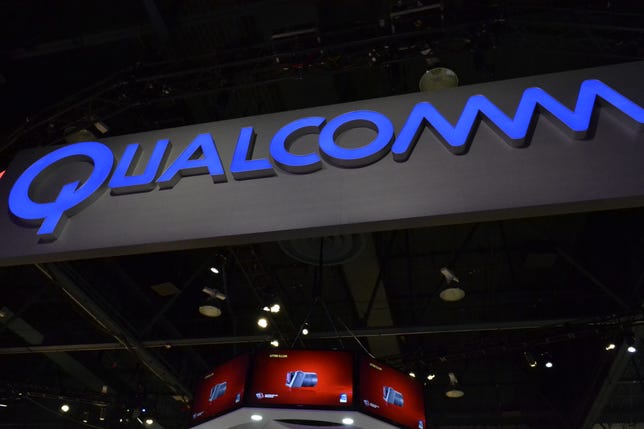
Ben Fox Rubin/CNET
Qualcomm had a lousy week. Actually, it’s been a lousy couple of months.
Just as the world’s largest maker of mobile chips has been facing rumors that its new top-of-the-line chip has overheating problems, Qualcomm on Wednesday disclosed that it expects a major customer to opt out of using that chip for an upcoming flagship smartphone — widely believed to be Samsung and its next Galaxy S smartphone. The loss, among other problems, was significant enough that Qualcomm was forced to cut its annual revenue forecast by $800 million. This caps off months of hand-wringing over an ongoing antimonopoly investigation in China.
All that negativity drove Qualcomm’s stock down 12 percent at the end of the week, with the company losing about $14 billion in market value.
The latest stumble from the San Diego, Calif., mobile bellwether provides a case study on how quickly fortunes can change in the highly competitive mobile world, in which business needs to be won with every new device. The long-term question for Qualcomm now is whether its latest troubles will provide an opening for its many rivals — including MediaTek, Intel and Marvell — to create a bigger alternative to Qualcomm’s Snapdragon brand, or if the chipmaker can quell the rumors and reassert its leading spot.
Qualcomm, for its part, believes the issues will not have a major effect on its dominance in the industry.


Sarah Tew/CNET
“We don’t see any structural problem, we don’t see anything that challenges our competitive position going forward,” Qualcomm executive Cristiano Amon, who helps lead the company’s chip sales, said in an interview Thursday. “We had one product cycle that went well, but not as good as we hoped because we lost one design.”
Amon also offered a strong defense of the company’s top-tier chip, the Snapdragon 810, that’s faced the overheating rumors. He said the 810 will be a dominant player in the next line of high-end mobile phones and tablets — being used in over 60 devices — with the company winning most major flagship phones running the Android and Windows Phone operating systems.
“There’s a lot of rumor and misinformation about the 810,” Amon said. “Categorically, we don’t see any problem with the chip.”
So far, the LG G Flex 2 and Xiaomi Mi Note Pro smartphones will include the 810. LG offered its defense of the chip, with a mobile executive saying last week “the chip’s performance is quite satisfactory,” according to Reuters. LG declined to comment for this story.
Addressing the overheating concerns, Joshua Ho — mobile editor for AnandTech, a site that publishes the results of independent tests of computer chips — said such problems have been generally resolved for chips. He hasn’t tested out a finished version of the 810 yet, so he couldn’t say if the chip had other issues.
“For the most part, this is a solved problem,” Ho said. “It’s no longer difficult to make a chip that doesn’t overheat.”
The next Samsung Galaxy S, though, is expected to include a chip from Samsung’s in-house Exynos line, which Samsung has been working to build up. It’s not yet clear if Qualcomm’s radio chip will still end up being used in that phone. Amon added that there is no separate version of the 810 being created — addressing another rumor that a special chip was being made to placate Samsung. During a call with analysts this week, Samsung executives declined to address which chip might be used in the new device.
Qualcomm still has an opportunity to turn around its fortunes after the recent troubles, analysts say. However, the market isn’t getting any easier, with heavy competition in the rapidly growing area of low-end smartphones driving down prices and profit margins.
RELATED STORIES
- Qualcomm expects to lose a large customer’s flagship device
- Qualcomm boosts the brains on its flagship Snapdragon 810 chip
- For Qualcomm, health care, autos represent the next frontier
Granted, any challenge to Qualcomm would be difficult. The company has remained the leading player in mobile for years and the latest chip figures prove that it should stay on top for a while. Qualcomm took in 64 percent of the revenue for mobile radio chips in the third quarter of last year, with the second-place player, MediaTek, hitting 17 percent, according to Strategy Analytics.
“Obviously, they’ve got to win that socket back, if just for sentiment if nothing else,” Bernstein Research analyst Stacy Rasgon said about Qualcomm winning back the Samsung Galaxy S phone a year from now. Still, the industry won’t know if Qualcomm succeeds for another 12 to 18 months — an eternity in the mobile world.
Qualcomm’s future prospects could improve with its next top-end Snapdragon chip, which will be more customized with Qualcomm technology than the 810, allowing the company to differentiate its product from those of its rivals. Qualcomm will have a chance to make up for lost business with this new chip, said FBR Capital analyst Chris Rolland, but competitors could end up stealing business in the meantime.
What the future could end up being for Qualcomm is unclear, but the company is certainly hoping it’s better than this week.



